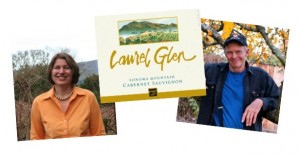 At 25, Laurel Glen’s owner belonged to a Zen Buddhist colony in Sonoma County. Although he already possessed a master’s degree in religion and was a professional musician, he wasn’t certain what his ultimate path would be. Among his first tasks at the colony, Patrick Campbell was assigned to tend the community vineyards, which ignited his passion for viticulture.
At 25, Laurel Glen’s owner belonged to a Zen Buddhist colony in Sonoma County. Although he already possessed a master’s degree in religion and was a professional musician, he wasn’t certain what his ultimate path would be. Among his first tasks at the colony, Patrick Campbell was assigned to tend the community vineyards, which ignited his passion for viticulture.
Three years later, Campbell had left the Buddhists to pursue his new path and, with the help of a small inheritance, purchased vineyard land in the Sonoma Mountain AVA, which had originally been planted in the late 1880s.
Patrick spent his initial years selling grapes to Chateau St. Jean and Kenwood until the lure of making his own wine became too powerful to ignore. He experimented with a barrel or two at a time until he felt confident that he could make wine on a larger scale. Consequently, he produced his first vintage in 1981—the Laurel Glen Cabernet Sauvignon.
In fact, Cabernet Sauvignon is all that Campbell does. More specifically, Campbell’s vineyards are planted with the Laurel Glen Cabernet Sauvignon clone, which was certified by the University of California at Davis.
While Cabernet Sauvignon is more commonly associated with Napa than with Sonoma, this grape variety can equally thrive in the western county. As a mountain appellation, the grapes are planted at an elevation of 800-1,000 feet. Here, the climate is slightly cooler, with the grapes receiving sunlight earlier in the day and avoiding the hotter afternoon rays of the valley floor. Thus, the height and exposure permit the grapes to retain acidity well and, ultimately, keep the wines balanced. Campbell’s light hand with French oak further adds to the elegance of these wines.
This was evidenced at a recent vertical tasting in New York. While the inaugural 1981 showed signs on age with its brick rim and developing aromas, it was still alive with medium+ acidity and notes of herbs, spice, cedar and blackberry on both the nose and palate. Subsequent wines tasted at the event showed a similar hallmark, although vintage variation and a slight style change over the years was evident.
Today, Laurel Glen includes 16 planted acres and produces 1,300-1,500 cases annually. A second wine, Counter Point, debuted in 1987 as an earlier-maturing option, and accounts for an additional 700-900 cases. Wine that doesn’t meet the standards for either the flagship wine or Counter Point is sold off as private label or on the bulk market, maintaining Campbell’s commitment to quality.
Thirty vintages on, Campbell has much of which to be proud. Laurel Glen was included in Paul Lukac’s book, Great Wines of America: The Top Forty Vintners, Vineyards, and Vintages (talk about a short list) and has developed a loyal following. So much so that he has been able to succeed without submitting wines to publications for review.
However, for Campbell, his path with Laurel Glen has come to an end. Instead, with Campbell’s recent sale of the winery, Bettina Sichel picks up where he leaves off, continuing her own family’s path in wine (she represents the 5th generation to work in the wine industry).
Sichel’s current journey began in November 2008 when a conversation with a friend ended with his statement, “We should buy a winery together some day.” After hanging up the phone, Sichel realized that it was the perfect time to consider such an opportunity and the two went on to raise money from investors to help move their goal forward. By July 2009, an action plan was in place, which included what they were looking for in a winery and why. Knowing that they wanted a winery with name recognition and a good history, Sichel went out to find a winery that fit the bill. After discovering that they couldn’t afford Napa, Sichel extended the search and found Laurel Glen to be a perfect fit. She acknowledges that it wasn’t easy and that she had to obtain a bank loan on top of the financing to make the dream a reality. However, she notes that buying Laurel Glen “is the culmination of everything I’ve worked for.”
Sichel is joined by winemaker Randall Watkins, consultant winemaker, David Ramey and viticulturist, Phil Coturri. Under Coturri’s tutelage, the vineyards are being farmed organically, along with a focus on dry farming, a more open canopy and fewer clusters per shoot.
But, despite these changes, Sichel holds fast to Laurel Glen’s illustrious history and stressed that the vibrant acidity that is characteristic of Laurel Glen will remain untouched. With Sichel at the helm, the winery is poised for continued success.
